Newest Abortion Statistics & Facts In The United States In 2024
Read the latest 2024 abortion statistics after the overturning of Roe V Wade and explore changes in US abortion rates in recent years.
Summary
Abortion is a very divisive topic. This is primarily due to the recent overturning of the landmark Supreme Court decision known as Roe V. Wade, which is at the forefront of American politics.
There are many opinions within the country on women’s abortion care and these opinions vary greatly between age, political affiliation, income, and geographic location. Abortion statistics show that the landscape of abortion services is changing and along with that changing women’s reproductive health.
Let’s explore how the overturning of the landmark Supreme Court decisions has impacted women’s reproductive rights and how different demographics view the issue.
Methodology
For our analysis of the abortion topic, we utilized related data from Statista – an online platform specialized in data gathering. We then used this to draw conclusions and correlations on the topic of abortions.
Additionally, we analyzed health statistics from the Centers for Disease Control in relation to abortion. This provided an additional exploration of the matter as it relates to women’s age at the time of abortion.
The State Of US Abortion Laws
It has been one year since the United States Supreme Court overturned the landmark case Roe v. Wade on June 24, 2022. It is important to note that nearly half of all abortions are medication-induced abortions and that most abortions occur within the first trimester.
Many states at this point in time are still providing abortion services for that time period.
However, within the past year, 15 states[1] have either limited abortion access up until 6 weeks of pregnancy or banned abortion care altogether. This is leading to a movement of women seeking health care in neighboring states.
This barrier to abortion care can disproportionately affect black women and poor women, who often do not have the means for such travel.
- 4 states have restricted abortions to up to 15 weeks.
- 5 states remain in legal limbo.
It should be noted that most abortions occur within the first trimester and many states at this point in time still provide abortion services for that time period.
- 27 states remain committed to the Roe V. Wade ruling and permit abortion up until 23 to 25 weeks of pregnancy.
Certain states however expect new legislation to tighten abortion rights, such as Arizona and Florida.
- The 27 states that guarantee a legal right to abortions are able to do so through state laws and legislation.
- Five of those states have actually protected a right to medically induced abortion either through state constitution or referendum.
However, the topic of abortion in the US is not always consistent along party lines and state legislation. For example, New Mexico (a Democrat-led state), New Hampshire (a Republican-led state), Pennsylvania, and Virginia (who have split party leadership) still remain states to obtain a legal abortion.
However, they do not have any protected abortion rights under their state laws.
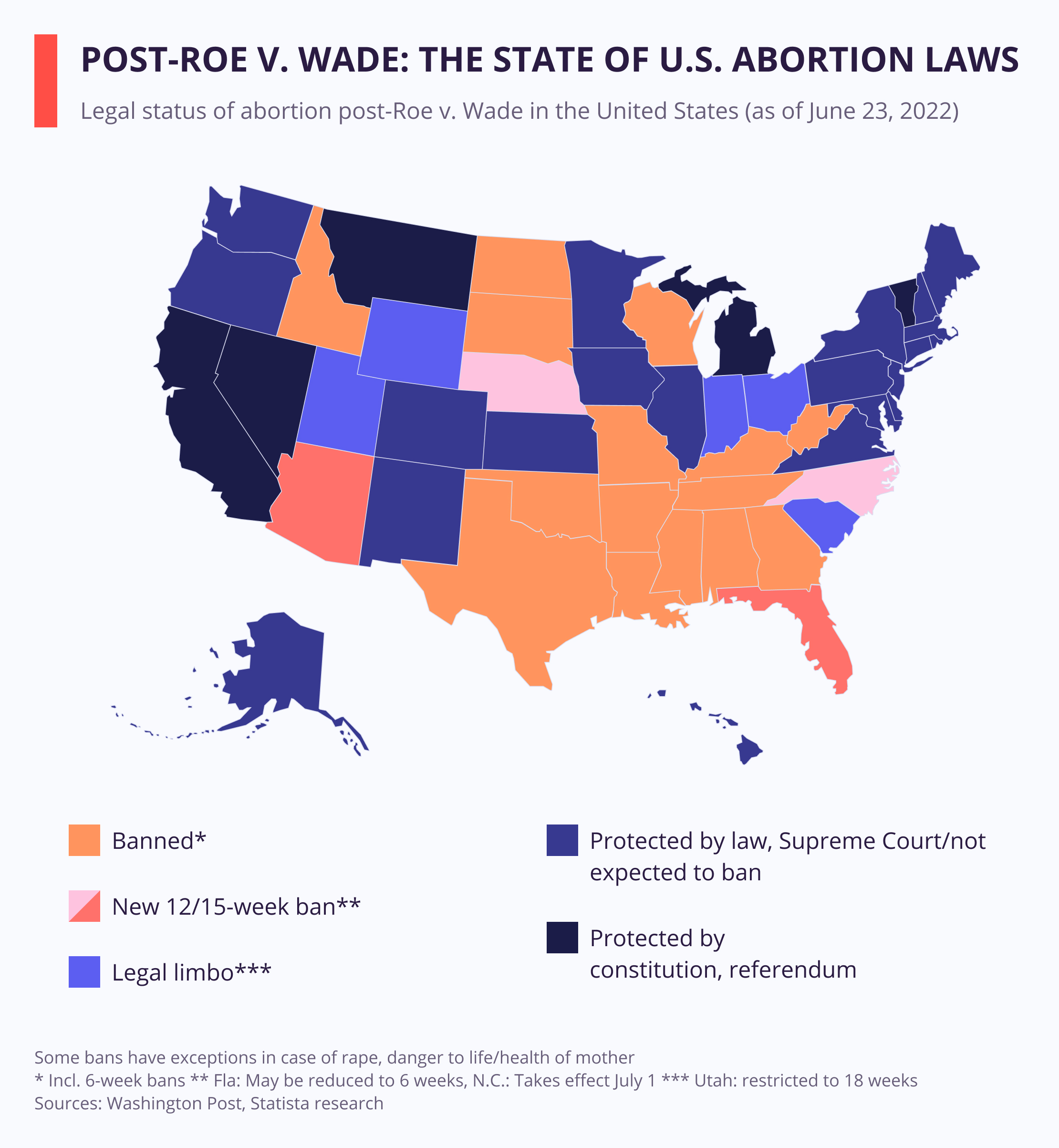
Ratios Of Legal Abortions Reported
By Age Per 1000 Live Births
Abortion rates differ greatly among various age groups.
- In 2011, the rate of reported abortions for women less than 15 years of age per 1,000 live births was about 850.
- In 2020, that rate is closer to 800.
Abortion rates have slightly increased for women ages 20-29 from 2011 to 2020 as compared to live births. However, abortions have been decreasing[2] for women who are 40 years or older from 2011 to 2020 as compared to the rate of live births.
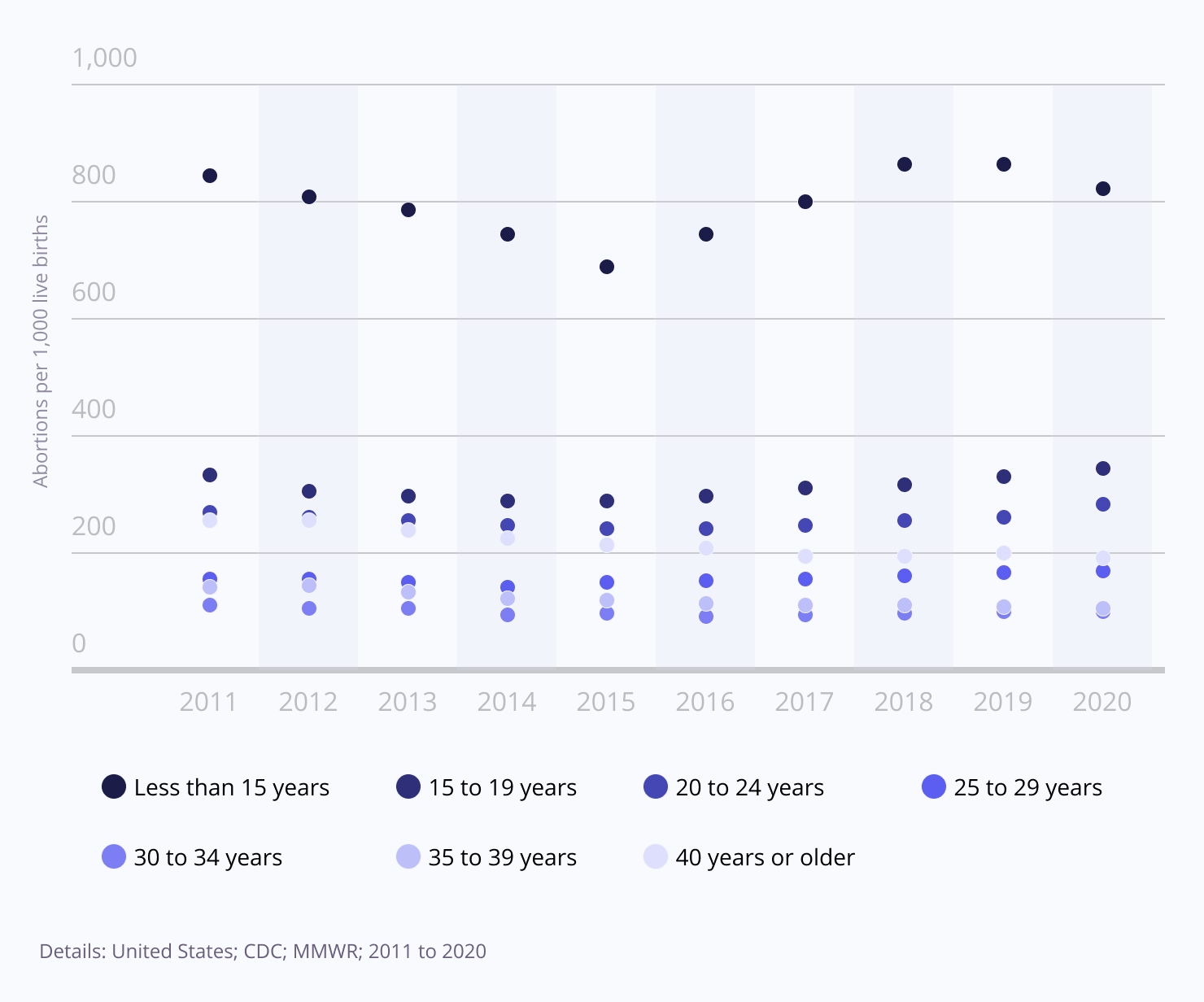
By Age Per 1000 Women
- For women 15 to 19 years old, the abortion rate dropped from 10.5[3] abortions per every 1000 women in 2011 to 5.5 abortions per 1,000 women in 2020.
- Abortions for women 20-24 years old also decreased from 25 abortions per every 1000 women in 2011 to 18.2 abortions per every 1000 women in 2020.
- For women ages 35-39, rates remained somewhat similar within the past decade and abortions occur at rates of 5.5 for every 1000 women.
- There also has been a slight decline in women ages 25-29, with 19.5 abortions per every 1000 women in 2011 to 18.2 abortions per 1,000 women in 2020.
- The abortion rate of women over the age of 40 remained fairly unchanged.
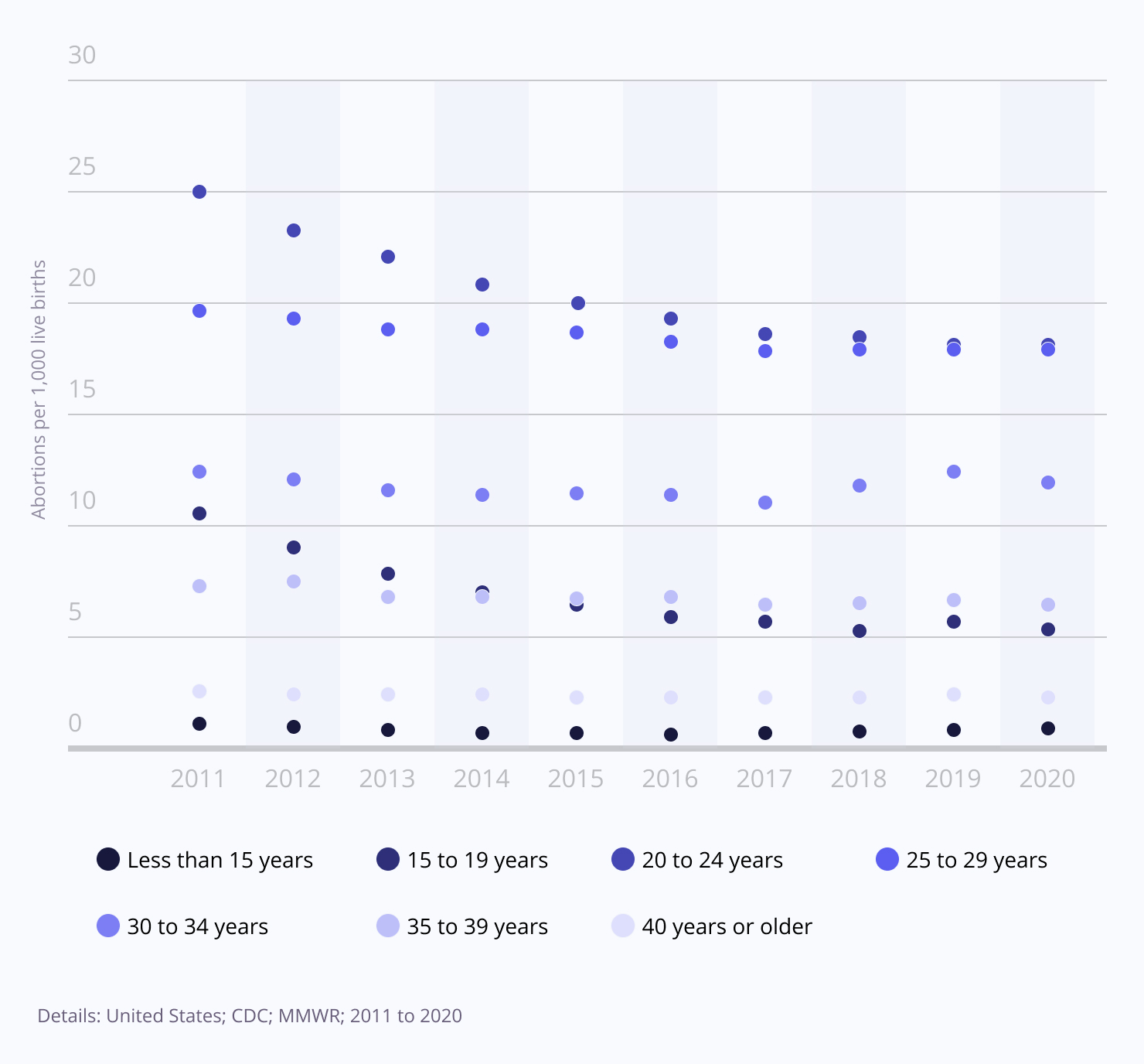
By State
In a 2020 analysis, there was great variation in abortion rates from state to state.
The states that had the highest rates of abortion amongst women aged 15-44 years old:
- Florida with 19.1[4] for every 1,000 women
- Illinois with 18.7 for every 1,000 women
- Georgia with 17.1 for every 1,000 women.
The states with the lowest rates were Wyoming with 0.8 women for every 1,000 and Missouri with 0.1 women for every 1,000.
U.S. Abortions Shift And Decrease

The number of monthly abortions performed in the United States decreased by an average of 2,850 between April 2022 and March 2023, based on abortion surveillance data.
This is following the ban or restriction of the procedure by several states after the Supreme Court overturned the precedent Roe v. Wade one year ago on June 24. However, in the midst of all new legislation from various states, there are a few states that have become safe haven states and have actually seen the number of legally induced abortions increase substantially. Data from the activist group Society of Family Planning[5] shows safe haven locations that some abortions have shifted to following the decision.

Florida’s ban on abortions after 15 weeks came into effect on July 1, 2022, They are still by far the least restrictive state for obtained abortions compared to their strict neighboring states.
- Illinois and Florida have seen their abortion surveillance data increase on average by 1,400[6] more abortions per month between the times of June 2022 and March 2023.
- Despite Florida’s ban on abortions after 15 weeks that came into effect on July 1, 2022, they are still by far the least restrictive state for obtained abortions compared to their strict neighboring states. Since 93% of abortions are usually performed at or before 13 weeks of gestational age, their current ban is unlikely to curb their abortion rate. Governor Ron DeSantis is making efforts to curb abortion services by signing a law banning abortion after 6 weeks of gestation, however, there is a pending court case that is stalling that law.
- North Carolina is another state that is seeing an increase in the abortion rate largely due to those coming from neighboring Georgia. North Carolina has seen an increase of an average of 881 abortions per month since 2022. On July 1st, North Carolina will see a new ban on abortions after 12 weeks of gestational age, however, just like with Florida’s current law. Because of this, the number of induced abortions will likely remain unchanged since most abortions tend to occur before 13 weeks.
- Colorado has seen an average increase in 500 legally induced abortions monthly
- Virginia and Kansas have had over 350 more per month on average.
- Other western states such as California, Oregon, and Washington have all seen an increase of up to 1000 more abortions as expected due to their legislation.

Texas with a decrease in the number of reported abortions of about 2,593.
However, the number of reported abortions did decrease in states with the strictest of laws.
- Texas did see a decrease of about 2,593
- Tennessee had a decrease of 1122.
The stricter laws are causing more travel out of state in order to obtain a medical abortion for an unintended pregnancy, however, that is not a new phenomenon.
In 2020, before the overturning of Roe V. Wade, an average of 9% of abortion patients traveled out of state to seek medical abortions, mostly due to a lack of abortion clinics in their state.
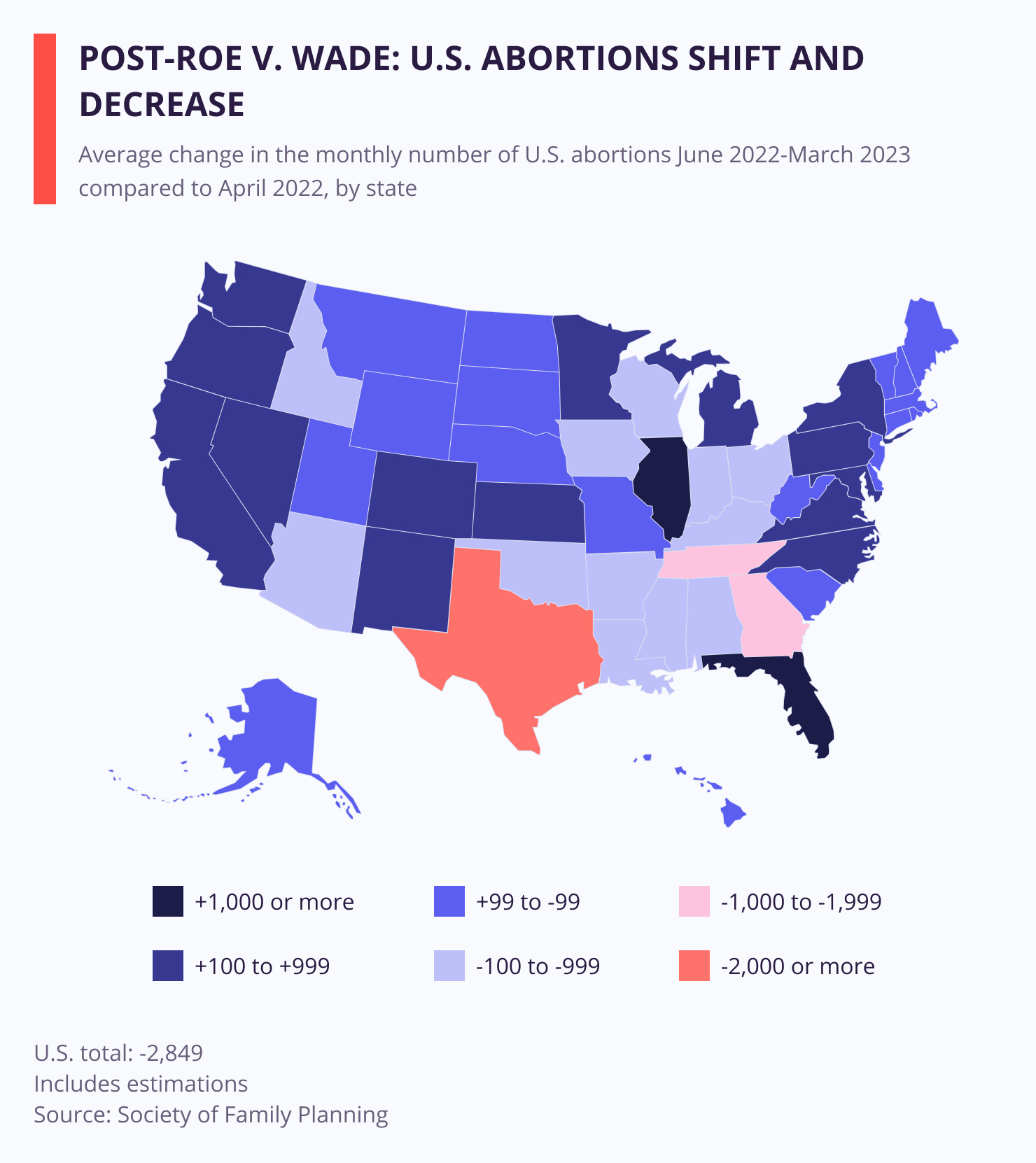
What Percentage Of Americans Are Pro-Choice?

Based on 2023 survey-reported data, it was found that 52% of respondents consider themselves pro-choice.
The divisiveness of abortion care for unintended pregnancies and for women’s health has been something that permeates US politics and party identification.
- Based on a 2023 survey[7] reported data, it was found that 52% of respondents consider themselves pro-choice, meaning that they believe women have autonomy over their bodies and should be able to make the decision of pregnancy terminations.

44% of respondents consider themselves pro-life supporters who oppose abortion access.
- 44% consider themselves pro-life supporters who oppose abortion access. Those numbers have slightly changed from 2003 when 48% considered themselves pro-choice and 45% considered pro-life.
Pro-life and Pro-choice
- Those who claim to be pro-life have the mindset that abortion is murder and that life begins at conception.
- Those who claim to be pro-choice are those who believe that it is a woman’s right to choose their reproductive health care.
- According to pewresearch.org,[8] those who are pro-life tend to be seen as most conservative, religious, and Republican.
- While those who are pro-choice tend to be more liberal and belong to the Democratic party.
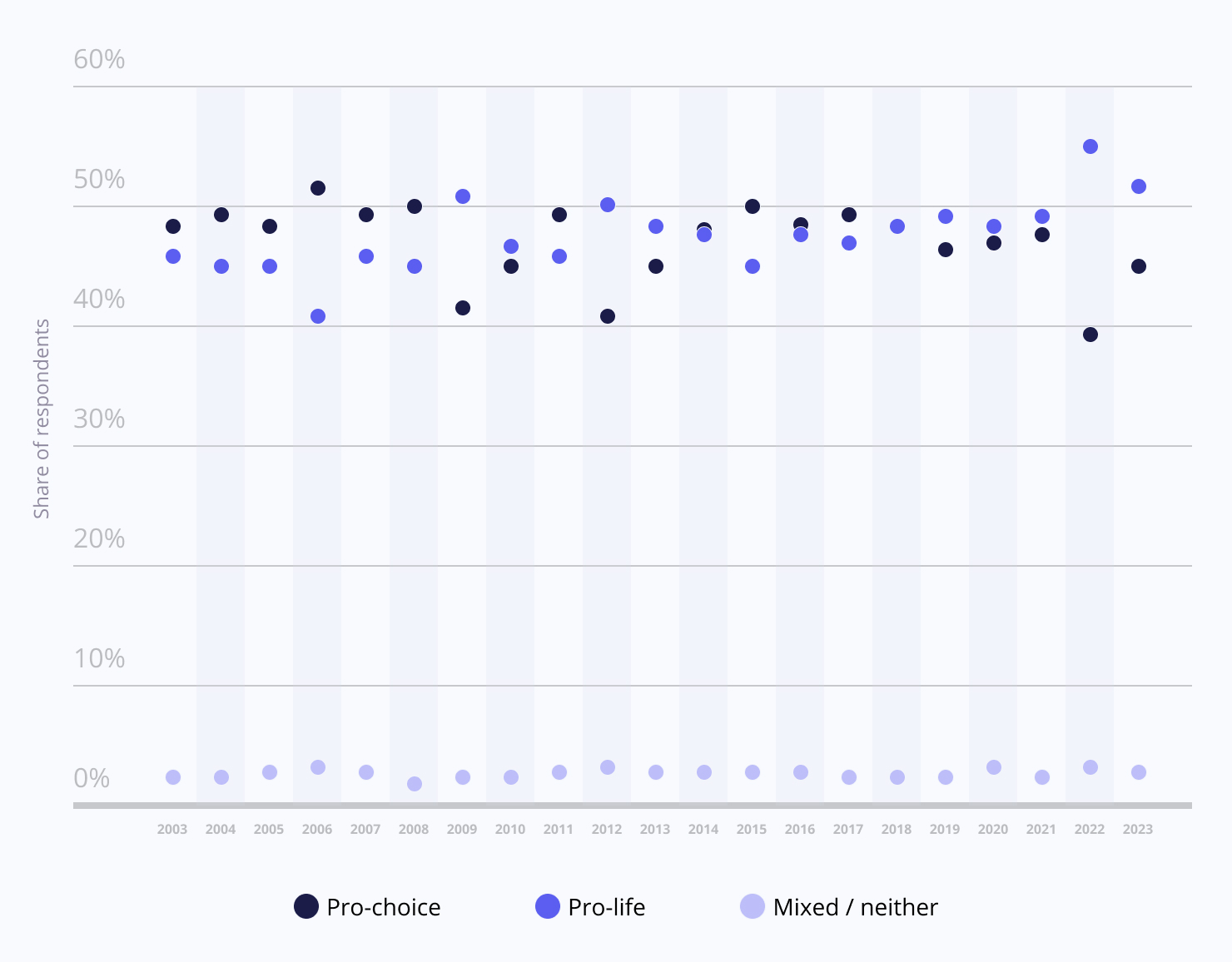
How Many Americans Support Abortion?
By Political Party & Level Of Legalization
It is perhaps no surprise that adults in the United States who identify as Democrats are far more likely to favor the legalization of abortion.
- 60%[9] of this position was supported by only 8% of Republicans.
- Only 4% of Democrats support abortion to be illegal in all circumstances.
- Of those who consider themselves Independent, 36% support abortion in all circumstances, while only 8% of Republicans support it in all cases.
- A high number of Republicans, 59%, support legally induced abortions only in a few circumstances.
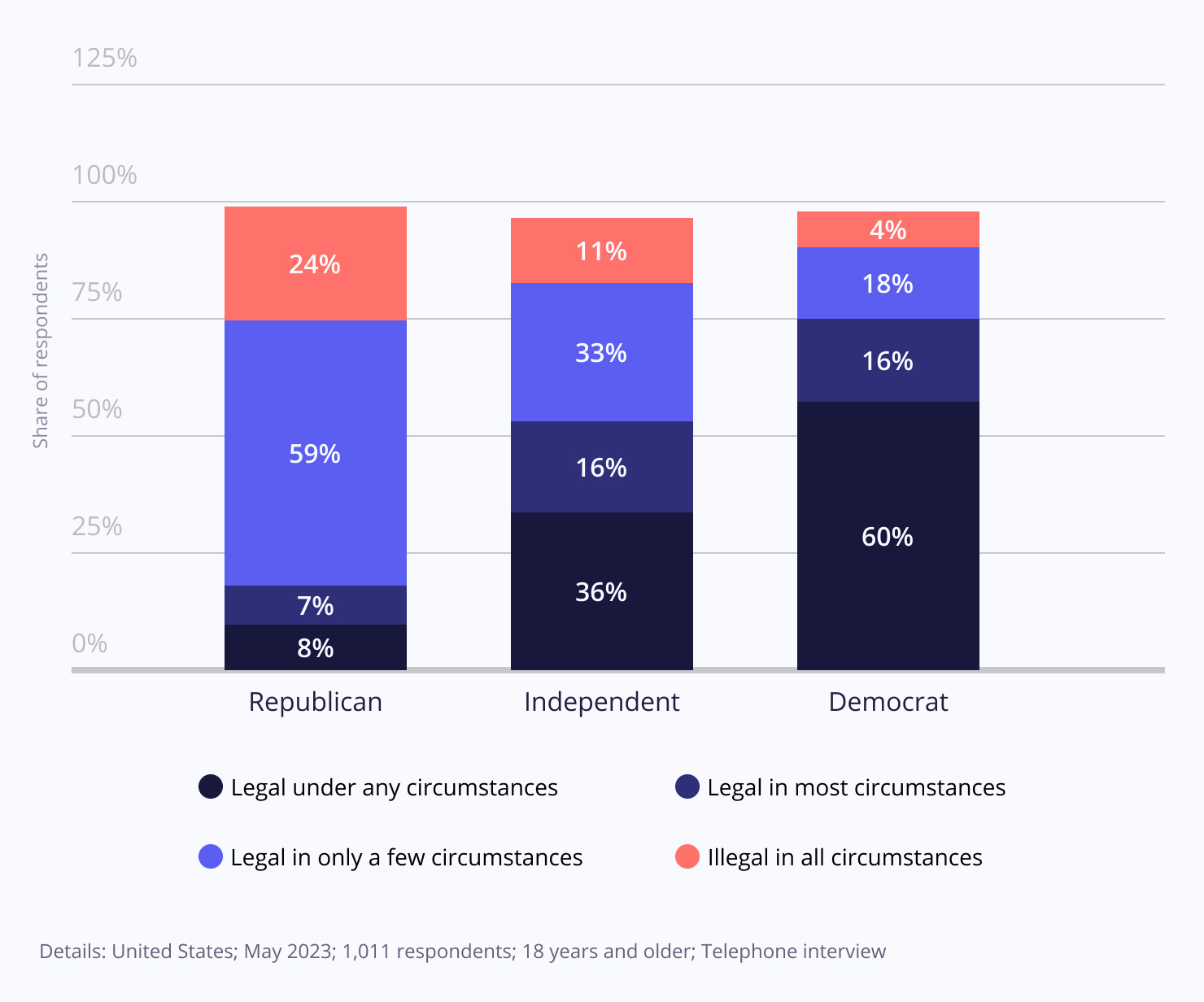
By Age & Level Of Legalization
Younger adults in the United States are far more likely to support the legalization of abortion.
- 2023 survey[10] found that 48% of respondents aged between 18 and 29 years favored the legalization of abortion under any circumstance.
- Of those who were between 30-49 years of age, 36% supported the legalization of abortion under any circumstance.
- Of those who are 50-64, 25% support abortion in all circumstances, while 43% support legally induced abortion in only a few circumstances.
- Of those over 65 years old, only 28% supported abortion in all cases.
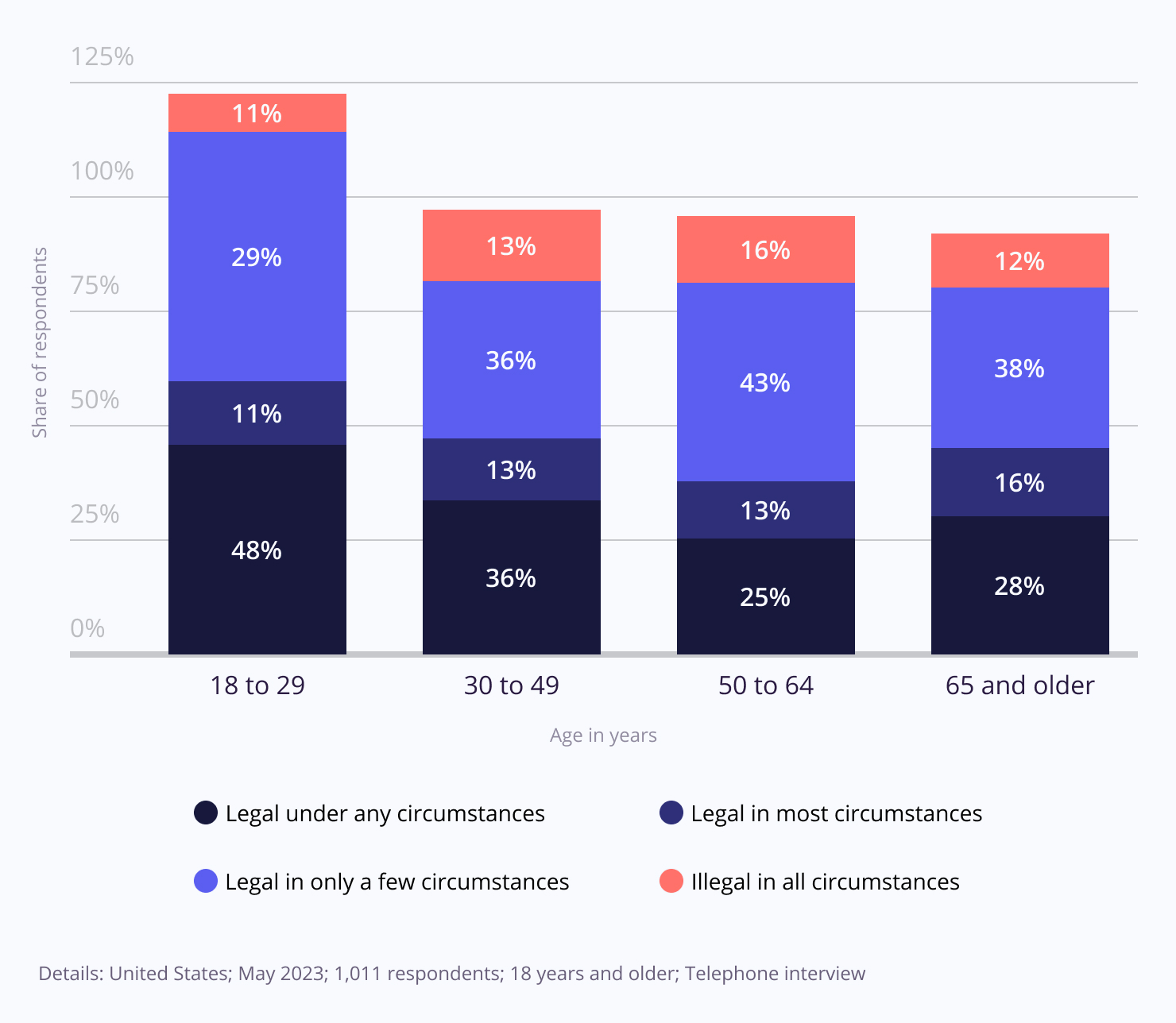
By Education & Level Of Legalization
Higher levels of education in the United States also contribute to opinions on reproductive health and the legalization of abortion.
Based on a 2023 survey[11]:
- 43% of college graduates stated that they support the legalization of abortion under any circumstance.
- Of those with postgraduate education, 42% supported abortion under any circumstance.
- 26% of respondents who did not go to college at all support abortion under any circumstances.
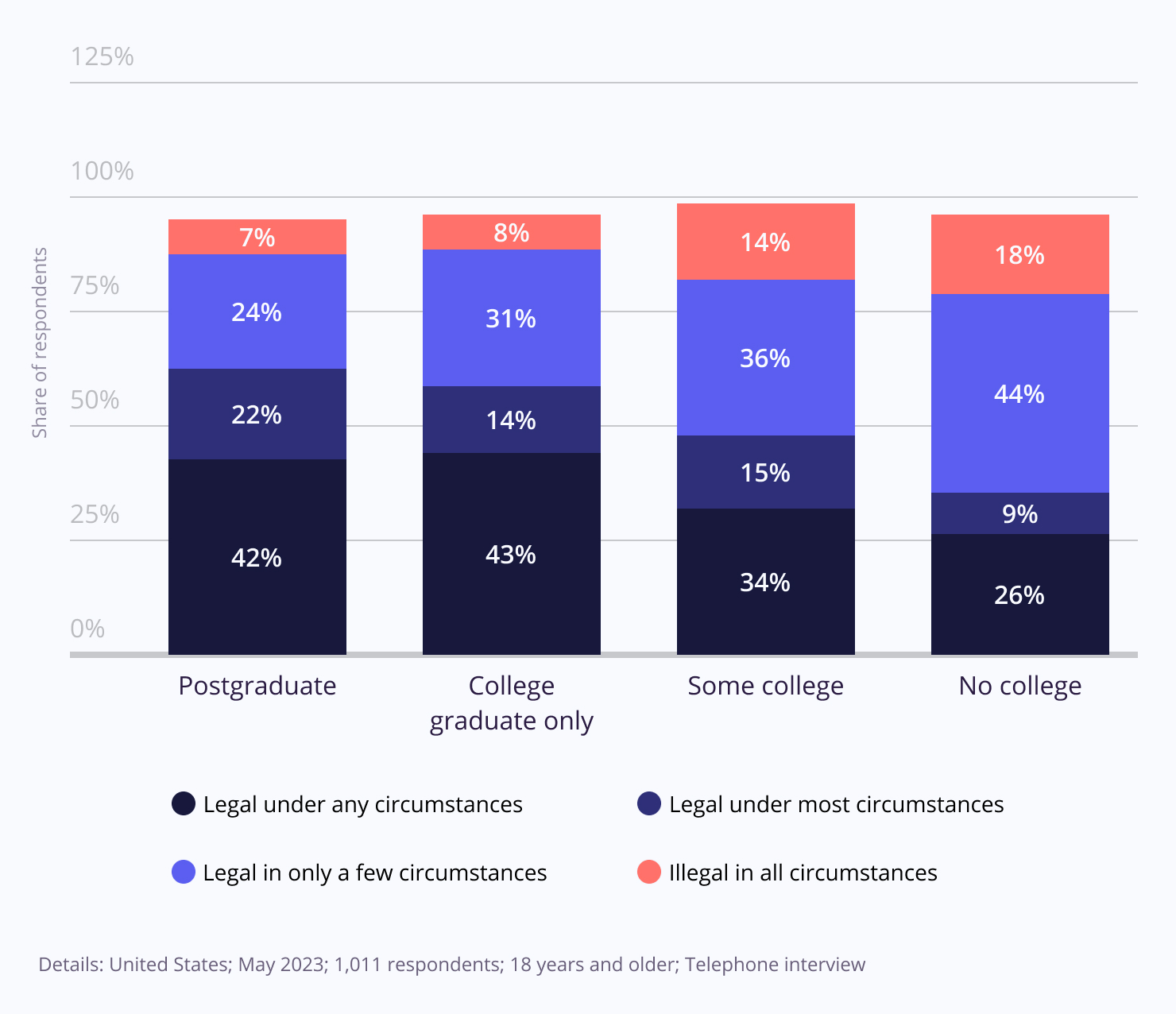
By Income & Level Of Legalization
According to a 2023 survey,[12] a higher income level is associated with a higher percentage of abortion support.
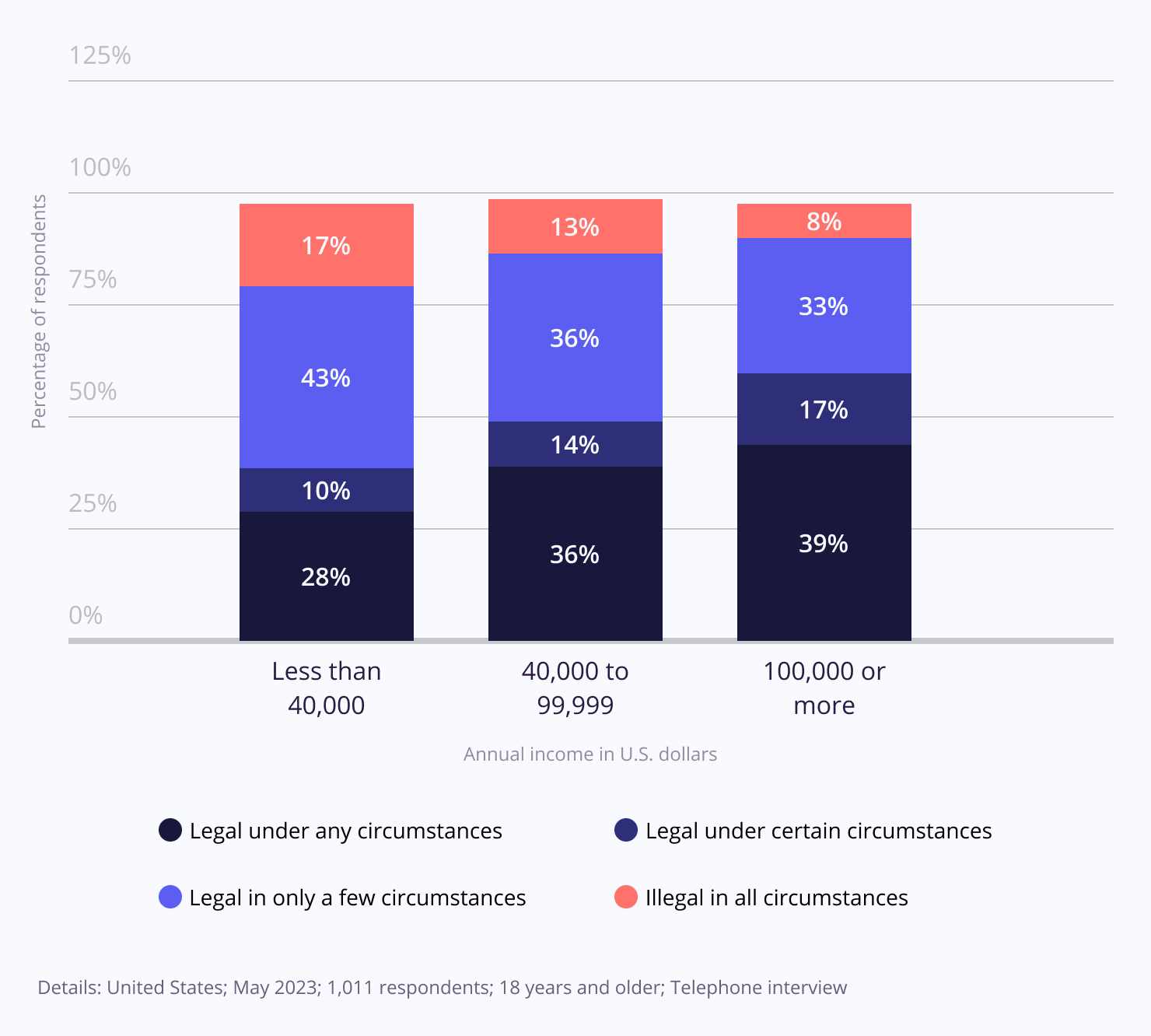
- 17% of adults in the United States earning less than 40,000 U.S. dollars per year favored outlawing abortions, and 28% believed that abortion should be legal under all circumstances.
- Of those earning above $100,000 annually only 8% favored outlawing abortions under any circumstance.
- Of those earning $40,000-$99,000 annually, 36% believe that abortions should be legal under all circumstances.
Planned Parenthood & Contraceptive Services
Distribution Of Contraceptive Services Provided By Planned Parenthood Affiliate Health Centers
Prevention of unintended pregnancy and women’s health services has been at the forefront of abortion statistics. Based on the data from Planned Parenthood affiliate health centers in the United States in 2021-2022, there are many contraceptives that have been deployed as preventive measures.
- Around 23%[13] of contraceptive services were for long-acting methods such as IUDs and implants.
- 30% of these services were for the oral pill
- 15% were for progestin-only injectables.
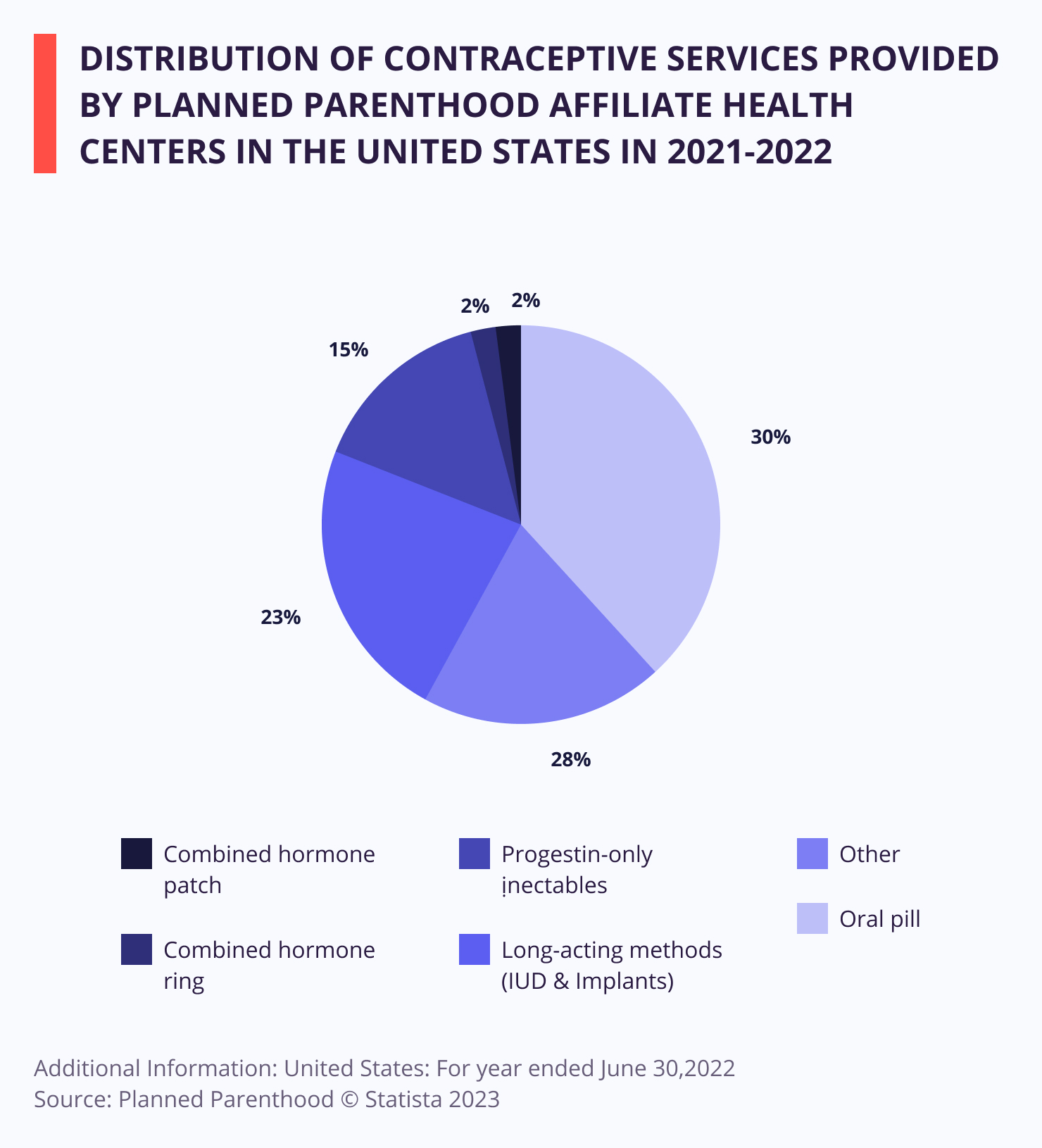
Number Of Services Provided By Planned Parenthood Affiliate Health Centers
In terms of services provided by Planned Parenthood Affiliate Health Centers, the number of abortions is far less than other health services. Based on data[14] from 2021-2022:
- 4% were abortion services by Planned Parenthood Affiliate Health Centers.
- 25% were contraception services by Planned Parenthood Affiliate Health Centers.
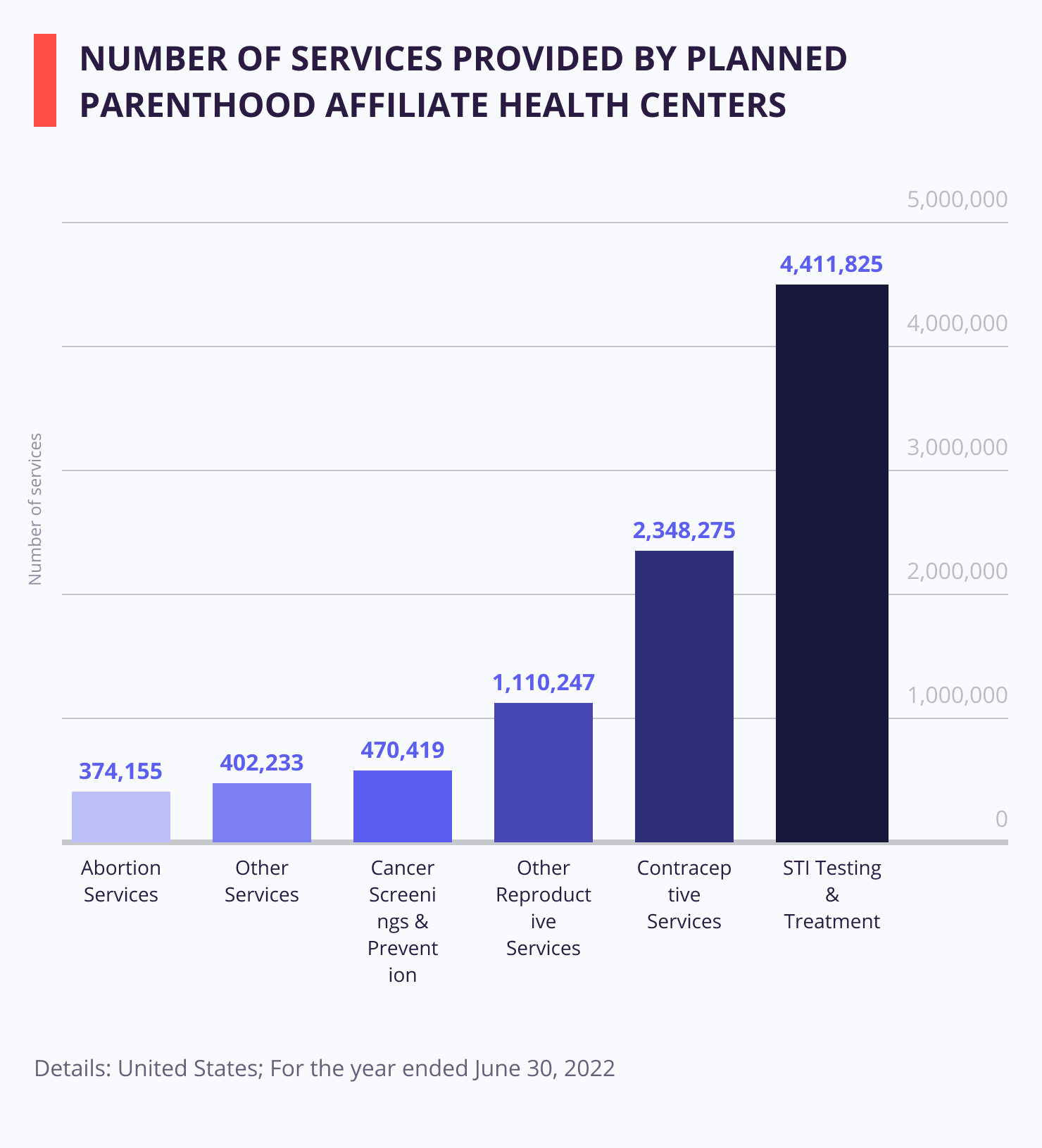
Women Employees With Abortion Health Plans & Services
Employers Offered Services To Women Employees Seeking Abortion Services
- 15%[15] of employers surveyed in the U.S. in 2022 mentioned they provided telemedicine support specifically for women seeking abortion services
- 12% offered navigation assistance.
- 16% of employers mentioned that they didn’t offer but are considering offering assistance to women seeking abortion services.
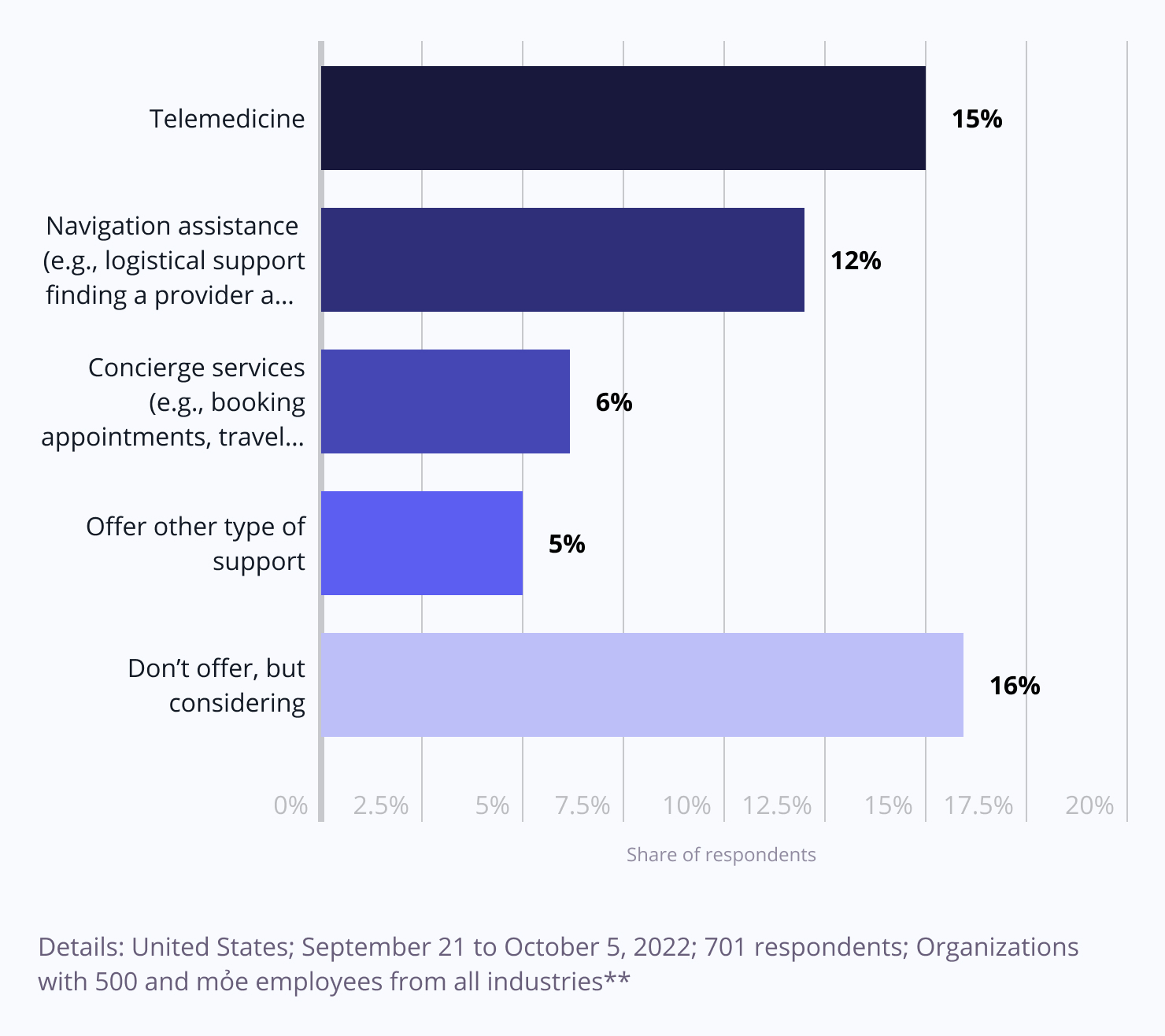
Employers’ Abortion Health Plans & Related Benefits
The following statistic[16] represents the level of coverage from employer health plans for abortion and related benefits in the U.S. in 2022.
- 48% of employers reported their health plans provided abortion coverage without restrictions
- 7% covered therapeutic medically necessary abortions for the health of the mother or for abnormalities of the fetus.
- 22% mentioned their health plans cover medically necessary abortions only.
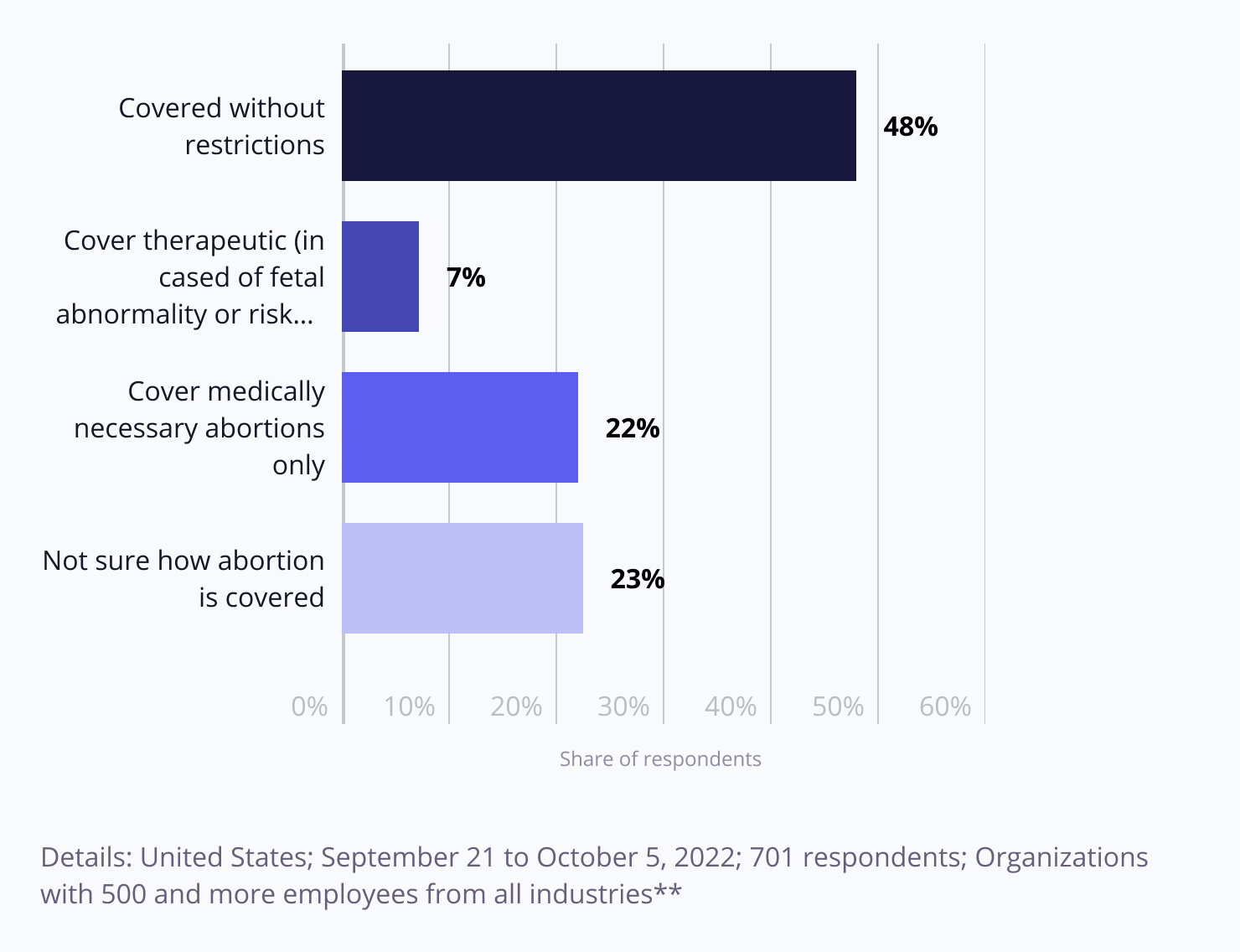
Conclusion
Reproductive health in the United States is a multifaceted issue. Various political and ideological beliefs play a huge role in the health of women as soon as they are of reproductive age. Certain access is limited due to state laws, insurance coverage, and even employer support.
The overall number of abortions reported has decreased according to abortion surveillance data since the overturning of Roe V. Wade. However, when one State sets out to ban abortion, it does not take into account travel to nearby states. There is also a risk of unsafe abortion which is underreported, along with the medication-assisted abortion that women now have access to.
Abortion facts and statistics are something that can be used by both pro-life and pro-choice sides in order to make a case for their constituents. There are many people with different viewpoints that weigh in on this issue. However, while the laws and bans shake out, women are stuck in the middle navigating an uncharted landscape in the post-Roe V. Wade world.
Author Information
Yelena Wheeler
Health Writer & Registered Dietitian Nutritionist
Media Contact
Erik Pham
Founder of Health Canal
[email protected]